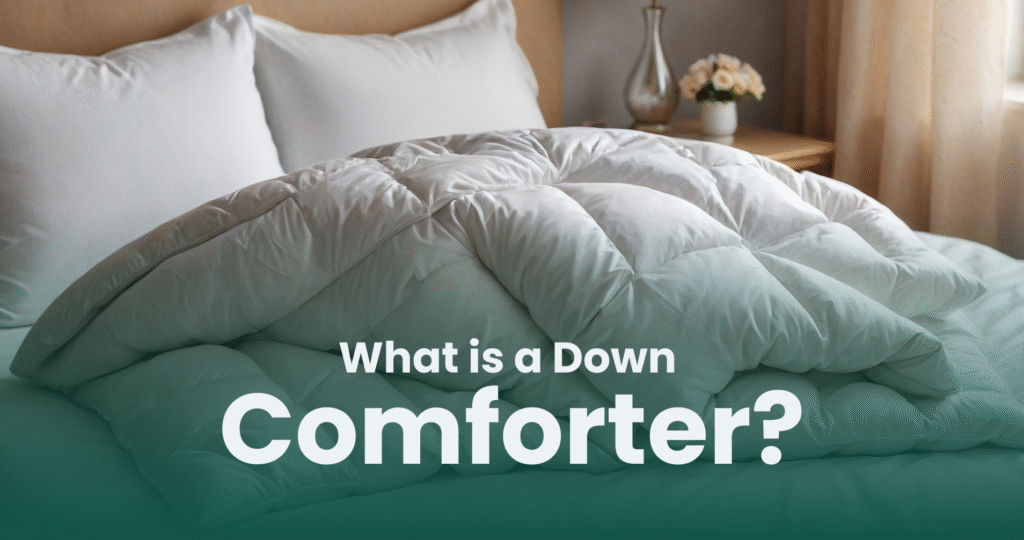The cloud-nine, never-leave-the-bed kind of comfort is what matters the most. We are talking about the fluffy down comforters, the king of all bedding that lets you have a restful night’s sleep.
If you’ve ever wrapped yourself in a down comforter, you were probably covered in a really plush blanket. However, what is a down comforter? Why is it seen as the symbol of coziness? And is the hype—and occasionally the cost—really worth it?
This down comforter buying guide will take you on a journey of what exactly down comforters are, including their pros and cons, and their care. So, let’s begin!
What Is A Down Comforter?
A down comforter is a kind of blanket or duvet that is filled with a fluffy, soft material that ducks and geese use under their feathers. The ultra-light, soft layer is what keeps them warm in cold weather.
Down is so wonderful because it creates insulation without adding weight by trapping air as if it were nothing.
Usually made of cotton or a cotton blend, a down comforter is sewn into a fabric shell. To maintain the down’s even distribution, the shell may be quilted or “baffled.”
It’s the grown-up, elegant version of that beloved blanket from your youth that you couldn’t part with.
Types of Down Bedding
You may have seen down comforters with the labels duck down or goose down. That signifies the following:
The Goose Down
- Larger clusters, particularly from mature geese.
- Usually more insulating, loftier, and softer.
- It’s usually more costly.
- Harvested more frequently in colder climates, which improves insulation.
Duck Down
- Down clusters that are a little smaller.
- More reasonably priced.
- Though less “cloud-like” than goose down, it’s nonetheless warm and comfortable.
Both are excellent, but goose down could be your best bet if you want to spend more money on maximum fluff.
What Is Fill Power?
You’ll hear the term “fill power” a lot.
The loft or fluff of the down is measured by fill power. It also shows how well it insulates.
- 400–500 fill power: Mild warmth, ideal for hot sleepers or summertime.
- 500–600 fill power: Excellent for all-season use; medium warmth.
- 600–800 fill power: Warm and fluffy is perfect for cooler areas.
- 800+ fill power: A luxurious loft that is incredibly cozy and appealing.
Better quality down is what is meant by higher fill power, not more down. Therefore, although a 700 fill power comforter may weigh less than a 500 fill power comforter, it will be warmer and puffier.
Pros and Cons of Down Comforters
Some crucial aspects make an all-season down comforter an ideal choice.
Pros of Down Comforters
Here are the down comforter benefits:
- Lightweight Warmth
Despite its weight, down comforters provide exceptional warmth. It makes you feel comfortable.
- Breathability
Down breathes naturally, even though it’s extremely warm. It allows moisture to stay out, preventing you from waking up soaked in sweat.
- Durability
With the right care, a well-made down comforter can last for 10 to 20 years or longer.
- Natural Insulation
Warm in cold weather and cool on sunny days, they are nature’s ideal temperature regulator.
Cons of Down Comforters
The cons of a lightweight down comforter are:
- The Price Tag
High-quality down comforters, specifically those made with goose down or high fill power, can be costly.
- Greater Maintenance
They require more care than synthetic bedding. Unless you have a high-capacity washer and dryer at home, washing them typically requires a trip to the laundromat or dry cleaner.
- Possible Allergies
Some people are nevertheless sensitive to natural down and may have allergic reactions, even though many down products are considered hypoallergenic.
- Not Suitable for Vegans
Down is not appropriate for vegans or others who care about animal welfare because it comes from ducks or geese (unless you explicitly seek ethically certified down).
- Sensitivity to Temperature
A down comforter, particularly one with a high fill power, may be too warm all year round for hot sleepers or in extremely hot areas. If so, a down alternative or lighter version would be more appropriate.
Furthermore, Bedding King ultra-soft, long-lasting bedding essentials, you’ll actually look forward to going to sleep.
Care for a Down Comforter
Many people believe that Down is picky. The reality? It only requires some care. So, here are some down comforter care tips:
Cleaning Advice
- To protect the comforter from oils, spills, and stains, use a duvet cover.
- When necessary, spot clean using a light soap.
- For a thorough cleaning, use a front-loading machine with a high capacity and a light detergent, or take it to a professional cleaner.
- To preserve fluff, dry completely on low heat using dryer balls or clean tennis balls.
Daily Maintenance
- To keep your comforter airy and redistribute the down, fluff it every morning.
- In warmer months, store in a breathable cotton bag instead of a plastic one.
Is It Worth the Investment?
The fact is that a high-quality down comforter is not cheap. However, it’s also not a yearly purchase.
The investment is in:
- Restful Sleep
- Increased Comfort
- Durable Bedding
- Everyday Luxury
Investing in something that truly enhances that experience, such as a down comforter, just makes sense.
Final Thoughts
There’s something really reassuring about a classic, natural product that remains the best. A down comforter is a nightly haven, not merely a piece of bedding. A gentle landing following a challenging day. Self-care in the form of a small luxury.
Once you put on your first real down comforter, there’s no going back, whether you’re decorating your ideal bedroom or just improving your sleeping quality.
Consider us to be your sleep help. Our goal is to assist you in finding bedding that feels as nice as it looks. Visit us now to find the best collection of down comforters.
